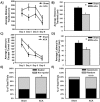Effect of cardiac arrest on cognitive impairment and hippocampal plasticity in middle-aged rats
- PMID: 25933411
- PMCID: PMC4416883
- DOI: 10.1371/journal.pone.0124918
Effect of cardiac arrest on cognitive impairment and hippocampal plasticity in middle-aged rats
Abstract
Cardiopulmonary arrest is a leading cause of death and disability in the United States that usually occurs in the aged population. Cardiac arrest (CA) induces global ischemia, disrupting global cerebral circulation that results in ischemic brain injury and leads to cognitive impairments in survivors. Ischemia-induced neuronal damage in the hippocampus following CA can result in the impairment of cognitive function including spatial memory. In the present study, we used a model of asphyxial CA (ACA) in nine month old male Fischer 344 rats to investigate cognitive and synaptic deficits following mild global cerebral ischemia. These experiments were performed with the goals of 1) establishing a model of CA in nine month old middle-aged rats; and 2) to test the hypothesis that learning and memory deficits develop following mild global cerebral ischemia in middle-aged rats. To test this hypothesis, spatial memory assays (Barnes circular platform maze and contextual fear conditioning) and field recordings (long-term potentiation and paired-pulse facilitation) were performed. We show that following ACA in nine month old middle-aged rats, there is significant impairment in spatial memory formation, paired-pulse facilitation n dysfunction, and a reduction in the number of non-compromised hippocampal Cornu Ammonis 1 and subiculum neurons. In conclusion, nine month old animals undergoing cardiac arrest have impaired survival, deficits in spatial memory formation, and synaptic dysfunction.
Conflict of interest statement
Figures





Similar articles
-
Comparison Impairments of Spatial Cognition and Hippocampal Synaptic Plasticity Between Prenatal and Postnatal Melamine Exposure in Male Adult Rats.Neurotox Res. 2016 Feb;29(2):218-29. doi: 10.1007/s12640-015-9578-0. Epub 2015 Nov 25. Neurotox Res. 2016. PMID: 26607910
-
Therapeutic hypothermia protects against ischemia-induced impairment of synaptic plasticity following juvenile cardiac arrest in sex-dependent manner.Neuroscience. 2016 Jun 14;325:132-41. doi: 10.1016/j.neuroscience.2016.03.052. Epub 2016 Mar 29. Neuroscience. 2016. PMID: 27033251 Free PMC article.
-
Hippocampal expression of myelin-associated inhibitors is induced with age-related cognitive decline and correlates with deficits of spatial learning and memory.J Neurochem. 2012 Apr;121(1):77-98. doi: 10.1111/j.1471-4159.2012.07671.x. Epub 2012 Feb 10. J Neurochem. 2012. PMID: 22269040 Free PMC article.
-
Global cerebral ischemia: synaptic and cognitive dysfunction.Curr Drug Targets. 2013 Jan 1;14(1):20-35. doi: 10.2174/138945013804806514. Curr Drug Targets. 2013. PMID: 23170794 Free PMC article. Review.
-
Dysregulation of Alzheimer's disease-related genes and proteins following cardiac arrest.Folia Neuropathol. 2017;55(4):283-288. doi: 10.5114/fn.2017.72384. Folia Neuropathol. 2017. PMID: 29363901 Review.
Cited by
-
Novel Modification of Potassium Chloride Induced Cardiac Arrest Model for Aged Mice.Aging Dis. 2018 Feb 1;9(1):31-39. doi: 10.14336/AD.2017.0221. eCollection 2018 Feb. Aging Dis. 2018. PMID: 29392079 Free PMC article.
-
Juvenile cerebral ischemia reveals age-dependent BDNF-TrkB signaling changes: Novel mechanism of recovery and therapeutic intervention.J Cereb Blood Flow Metab. 2018 Dec;38(12):2223-2235. doi: 10.1177/0271678X18766421. Epub 2018 Apr 3. J Cereb Blood Flow Metab. 2018. PMID: 29611441 Free PMC article.
-
Neuroinflammation in Post-Ischemic Neurodegeneration of the Brain: Friend, Foe, or Both?Int J Mol Sci. 2021 Apr 23;22(9):4405. doi: 10.3390/ijms22094405. Int J Mol Sci. 2021. PMID: 33922467 Free PMC article. Review.
-
Shared Genomic and Proteomic Contribution of Amyloid and Tau Protein Characteristic of Alzheimer's Disease to Brain Ischemia.Int J Mol Sci. 2020 Apr 30;21(9):3186. doi: 10.3390/ijms21093186. Int J Mol Sci. 2020. PMID: 32366028 Free PMC article. Review.
-
Myricetin as a Promising Molecule for the Treatment of Post-Ischemic Brain Neurodegeneration.Nutrients. 2021 Jan 24;13(2):342. doi: 10.3390/nu13020342. Nutrients. 2021. PMID: 33498897 Free PMC article. Review.
References
-
- McNally B, Robb R, Mehta M, Vellano K, Valderrama AL, Yoon PW, et al. Out-of-hospital cardiac arrest surveillance—Cardiac Arrest Registry to Enhance Survival (CARES), United States, October 1, 2005—December 31, 2010. MMWR Surveillance summaries: Morbidity and mortality weekly report Surveillance summaries / CDC. 2011. July 29;60(8):1–19. . Epub 2011/07/29. eng. - PubMed
-
- Nichol G, Thomas E, Callaway CW, Hedges J, Powell JL, Aufderheide TP, et al. Regional variation in out-of-hospital cardiac arrest incidence and outcome. JAMA: the journal of the American Medical Association. 2008. September 24;300(12):1423–31. PMCID: 3187919. Epub 2008/09/25. eng. 10.1001/jama.300.12.1423 - DOI - PMC - PubMed
Publication types
MeSH terms
Grants and funding
LinkOut - more resources
Full Text Sources
Other Literature Sources
Medical

